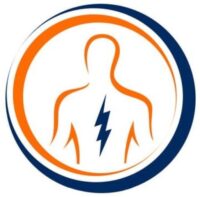De Quervain’s Tenosynovitis is the most common overuse injury involving the wrist. Individuals who regularly use a forceful grasp alomg with ulnar deviation of the wrist are more prone to this injury. Today, in this article, we are going to discuss De Quervain’s Tenosynovitis exercises and treatment.
De Quervain’s tenosynovitis describes a condition in which the muscles and tendons that attach to the thumb become irritated. It is a thickening of the sheath comprising the tendons of the extensor pollicis brevis (EPB) and the abductor pollicis longus (APL).
This issue produces pain on the thumb or radial side of the wrist. It develops when the wrist and thumb are used excessively such as activities like gaming, texting, gardening, and racquet sports.
Before we get into de Quervain’s tenosynovitis exercises and treatment, first have a look at how to examine this issue.
Examination of De Quervain’s Tenosynovitis
Examination of this issue includes the tests below. These tests are very effective in the diagnosis of De Quervain’s Tenosynovitis. If these tests reproduce your pain, then you may be suffering from this issue.
FINKELSTEIN TEST
In this test, the patient has to make a fist over the flexed thumb. Then there will be the ulnar deviation of the wrist. If this test reproduces pain during this movement, then you may be suffering from this issue.
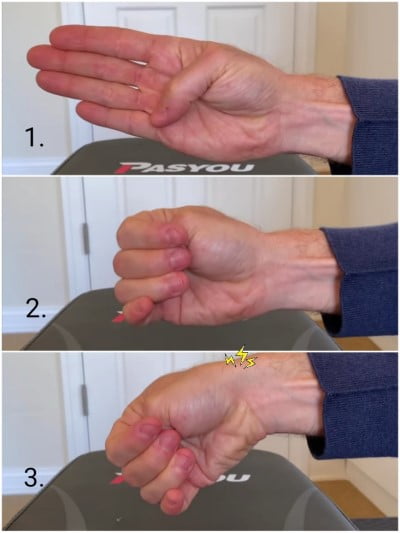
WHAT TEST
WHAT test -‘wrist hyperflexion and thumb abduction’. As the name showing, in this, the patient has to hyperflex his wrist. After that, there will be the abduction of the thumb in the hyperflexed wrist. If this movement is elicitating pain, then there is a chance of occurrence of this issue.
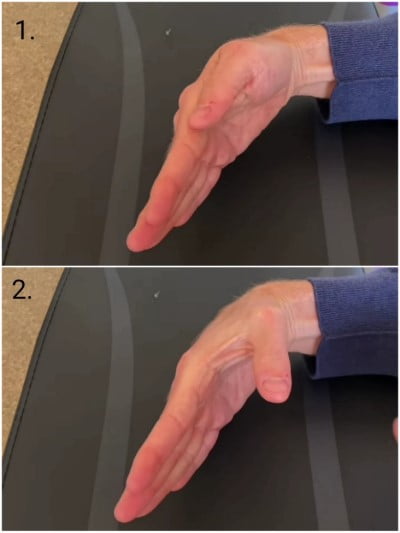
Treatment of De Quervain’s Tenosynovitis
Treatment includes rest, NSAIDs, local infiltration of hydrocortisone, & sometimes surgery.
1. Education:
Educating the patient about the basic anatomy and the aggravating factors is extremely important. Advising the patient to avoid activities that aggravate pain is important. Evaluation and modification of the workspace ergonomically to accommodate normal alignment of the wrist and hand can also be helpful.
2. Immobilization:
Immobilization of the wrist and thumb by using a radial-thumb spica splint is a common first-tier treatment. The splint should be of proper fitting and it should allow the wrist in a neutral position. The interphalangeal should remain free with full mobility. Immobilization, until the pain subsides, usually in 2-4 weeks should be maintained.
3. Anti-inflammatory drugs:
Anti-inflammatory medication along with other methods of treatment can be effective for de Quervain’s tenosynovitis. NSAIDs can also be a part of treatment initially. The combination of oral NSAIDs along with immobilization is effective in improving symptoms in more than 80% of the patients. NSAIDs alone generally are not effective.
4. Modalities:
Modalities like TENS, contrast bath, iontophoresis, SWD, and ultrasound, according to the severity of the condition are very effective. Cryotherapy is helpful during the early stages of de Quervain’s tenosynovitis.
5. Corticosteroid Injection:
In patients with severe pain and in whom, immobilization and therapy do not relieve symptoms, corticosteroids are injected. The injection is put into the sheath surrounding the first dorsal compartment of the forearm. This injection provides pain relief in nearly 70% of the patients.
6. Surgery:
If conservative treatment and injections consistently fail, then the role of surgery comes into play. Local anesthesia is sufficient and, through a small incision over the first dorsal compartment, the thick sheath of the EPL & APB tendons is divided to decompress the compartment and allow the tendons to glide freely. ROM exercises after the surgery are very important. Strengthening exercises should be there in the rehabilitation program in later stages of recovery.
De Quervain’s Tenosynovitis Exercises
De Quervain’s Tenosynovitis exercises are very beneficial for one who is suffering from this problem. The patient can perform these exercises at home very easily.
The first goal of this exercise program is to restore function and mobility. After gaining ROM and function, strengthening exercises will be introduced.
Points to be kept in mind before doing these exercises:
- Avoid jerky movements.
- Stretch as much as you can with ease. Do not overstretch.
- Don’t force yourself into any movement.
De Quervain’s Tenosynovitis Exercises- In Early Phase:
In the initial stages of rehabilitation, the passive movements will help to regain full mobility and function. After that, active movements will take part but without any external resistance.
1. PASSIVE RADIAL ABDUCTION OF THE THUMB
- Place your wrist in a neutral and stable position.
- Move your thumb away from your fingers in the plane of your palm using your unaffected hand.
- Hold your thumb in the abducted position for 5 seconds.
- Repeat 3 times.
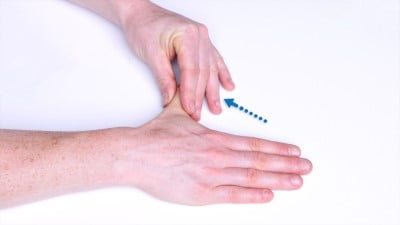
2. PASSIVE PALMAR ABDUCTION OF THE THUMB
- The position of the wrist will be the same as above.
- Move your thumb away from your fingers but this time perpendicular to the palm be using your unaffected hand.
- The rest will be the same as above.
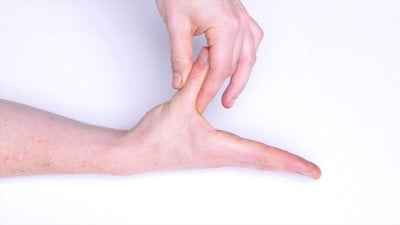
3. RADIAL ABDUCTION OF THE THUMB
- This will be the same as 1 but in this, the thumb will be abducted actively without using the unaffected hand.
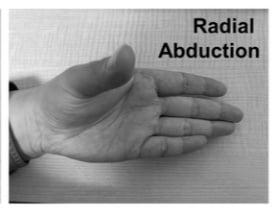
4. palmar abduction of the thumb
- This will be the same as 2 but in this, the thumb will be palmar abducted actively without using your unaffected hand.
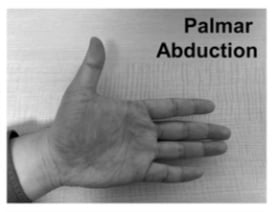
5. THUMB OPPOSITION
- Touch each fingertip by using the tip of your thumb.
- After than reach the base of your little finger with the tip of your thumb.
- Repeat 5 times.

6. wrist flexion and extension
- Bend your wrist forward first and hold it there for 5 seconds.
- After that, bend your wrist backward and again hold for 5 seconds.
- Repeat both the movements 5-10 times.
Do this exercise passively first (Fig. 1) using your unaffected hand and then without the assistance of another hand. (Fig. 2)

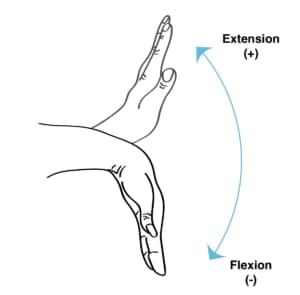
7. ULNAR DEVIATION
- Bend your wrist towards your little finger by keeping your thumb next to the index finger. Hold for 10 seconds and repeat 5 times.
- Again do this movement but this time by making a fist as shown below.
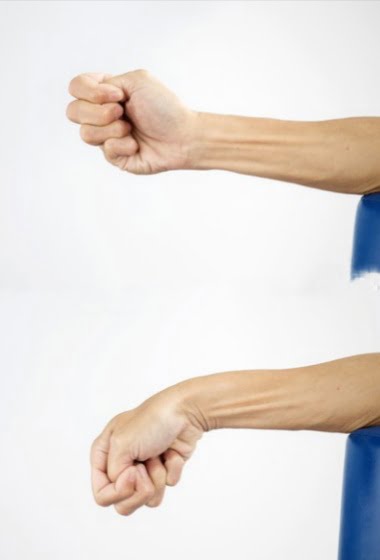
NOTE: All the exercises mentioned above should be done 2-3 times a day.

De Quervain’s Tenosynovitis Exercises- In Later Stages:
After gaining full ROM and mobility by doing the above exercises, the next step is to introduce resistance exercises to increase strength.
For this, you will need a lightweight dumbbell and a thera-band.
1. WRIST FLEXION
- Sit with your arm resting on a table with the palm facing upwards.
- Grasp a lightweight dumbbell in your hand and curl your wrist upwards.
- Do 2-3 reps with 10 reps each.
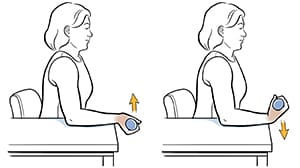
2. WRIST EXTENSION
- While holding a dumbbell in your hand, bend your wrist downwards.
- Get the weight back up by extending the wrist.
- Do 2-3 sets of 10 reps each.
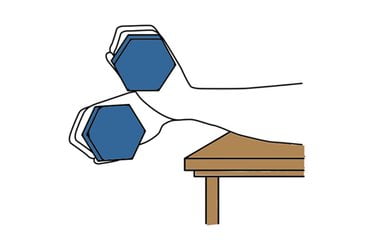
3. ULNAR DEVIATION OF THE WRIST
- Stand straight and grasp a dumbbell in your hands with palms facing towards your body.
- Bend your wrist towards the side of your little finger and then lower the weight.
- Do 2-3 sets of 10 reps each.
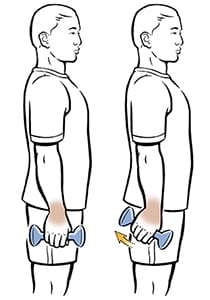
4. RADIAL DEVIATION OF THE WRIST
- Grasp a lightweight dumbbell in your hand and keep your palm face towards your body.
- Bend your wrist towards the thumb and then get back to the starting position.
- Do 2-3 sets of 10 reps each.
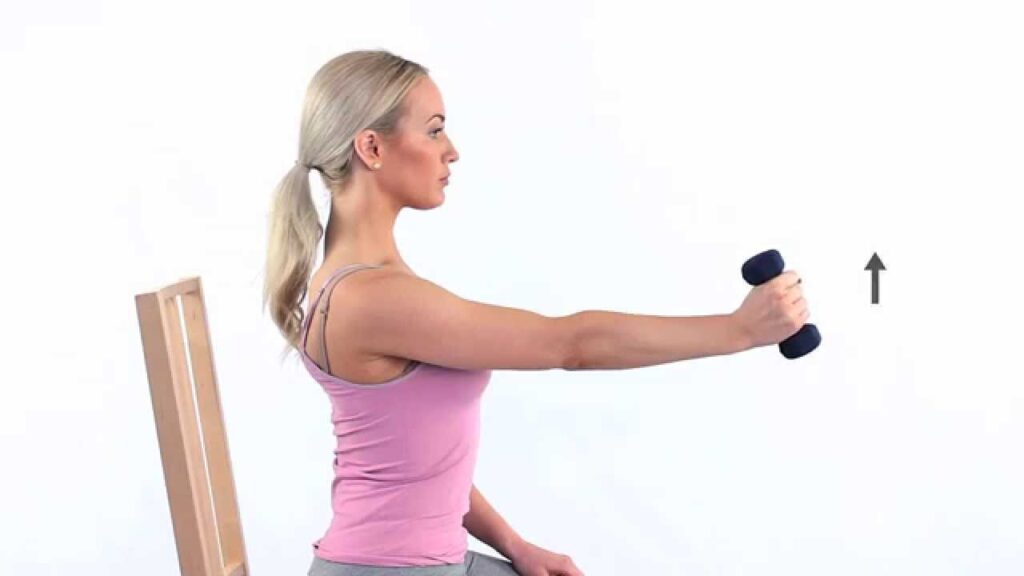
6. THERA-BAND THUMB EXTENSION
- Wrap a band around your fingers and thumb as shown in the picture.
- While keeping your fingers stationary, extend your thumb against the band.
- Do 2-3 sets of 10 reps each.

7. THERA-BAND THUMB ABDUCTION AND FINGER EXTENSION
- Wrap a band around your fingers and thumb as shown in the picture.
- Now, extend your fingers and abduct your thumb against the resistance of the band.
- Do 2-3 sets of 10 reps each.
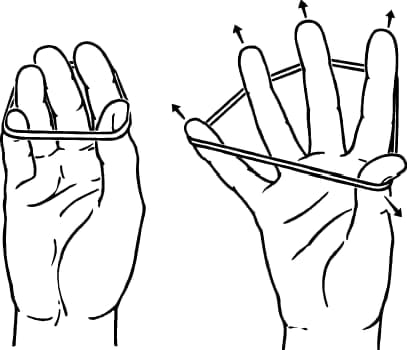
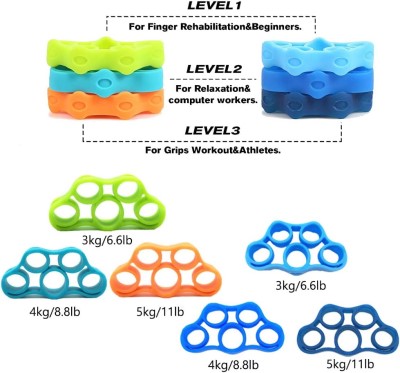
Conclusion:
Effective management of de Quervain’s tenosynovitis requires a highly systematic approach. Splinting in the early stages is helpful as it will prevent further aggravation of the tissues. It also allows early recovery.
The patient must be educated to avoid some movements that can elicit more pain. Exercises should be done with care and before heading towards the resistance exercises, the patient must regain full mobility and must be pain-free.
ALL THE BEST!
